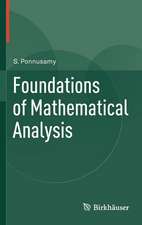Foundations of Modern Potential Theory: Grundlehren der mathematischen Wissenschaften, cartea 180
Autor Naum S. Landkof Traducere de A. P. Doohovskoyen Limba Engleză Paperback – 15 noi 2011
Din seria Grundlehren der mathematischen Wissenschaften
-
 Preț: 353.84 lei
Preț: 353.84 lei - 24%
 Preț: 728.15 lei
Preț: 728.15 lei -
 Preț: 410.21 lei
Preț: 410.21 lei - 24%
 Preț: 587.87 lei
Preț: 587.87 lei - 17%
 Preț: 498.73 lei
Preț: 498.73 lei -
 Preț: 592.75 lei
Preț: 592.75 lei - 20%
 Preț: 692.49 lei
Preț: 692.49 lei - 24%
 Preț: 893.28 lei
Preț: 893.28 lei - 20%
 Preț: 824.73 lei
Preț: 824.73 lei - 24%
 Preț: 632.96 lei
Preț: 632.96 lei - 15%
 Preț: 596.69 lei
Preț: 596.69 lei - 15%
 Preț: 714.49 lei
Preț: 714.49 lei -
 Preț: 333.01 lei
Preț: 333.01 lei - 15%
 Preț: 473.16 lei
Preț: 473.16 lei -
 Preț: 356.49 lei
Preț: 356.49 lei -
 Preț: 484.43 lei
Preț: 484.43 lei - 15%
 Preț: 452.79 lei
Preț: 452.79 lei -
 Preț: 456.66 lei
Preț: 456.66 lei - 15%
 Preț: 708.75 lei
Preț: 708.75 lei -
 Preț: 423.08 lei
Preț: 423.08 lei - 15%
 Preț: 444.29 lei
Preț: 444.29 lei - 15%
 Preț: 527.79 lei
Preț: 527.79 lei - 15%
 Preț: 589.65 lei
Preț: 589.65 lei -
 Preț: 353.40 lei
Preț: 353.40 lei - 18%
 Preț: 727.66 lei
Preț: 727.66 lei -
 Preț: 387.96 lei
Preț: 387.96 lei - 15%
 Preț: 454.74 lei
Preț: 454.74 lei - 15%
 Preț: 481.03 lei
Preț: 481.03 lei -
 Preț: 464.55 lei
Preț: 464.55 lei -
 Preț: 348.77 lei
Preț: 348.77 lei -
 Preț: 362.04 lei
Preț: 362.04 lei -
 Preț: 488.12 lei
Preț: 488.12 lei - 15%
 Preț: 447.57 lei
Preț: 447.57 lei -
 Preț: 419.81 lei
Preț: 419.81 lei -
 Preț: 388.52 lei
Preț: 388.52 lei -
 Preț: 419.21 lei
Preț: 419.21 lei - 15%
 Preț: 581.01 lei
Preț: 581.01 lei -
 Preț: 497.75 lei
Preț: 497.75 lei -
 Preț: 360.53 lei
Preț: 360.53 lei -
 Preț: 387.75 lei
Preț: 387.75 lei -
 Preț: 419.81 lei
Preț: 419.81 lei - 18%
 Preț: 725.75 lei
Preț: 725.75 lei -
 Preț: 453.78 lei
Preț: 453.78 lei -
 Preț: 386.39 lei
Preț: 386.39 lei
Preț: 787.15 lei
Preț vechi: 959.94 lei
-18% Nou
Puncte Express: 1181
Preț estimativ în valută:
150.64€ • 156.38$ • 125.61£
150.64€ • 156.38$ • 125.61£
Carte tipărită la comandă
Livrare economică 22 martie-05 aprilie
Preluare comenzi: 021 569.72.76
Specificații
ISBN-13: 9783642651854
ISBN-10: 3642651852
Pagini: 444
Ilustrații: X, 426 p.
Dimensiuni: 152 x 229 x 23 mm
Greutate: 0.59 kg
Ediția:1972
Editura: Springer Berlin, Heidelberg
Colecția Springer
Seria Grundlehren der mathematischen Wissenschaften
Locul publicării:Berlin, Heidelberg, Germany
ISBN-10: 3642651852
Pagini: 444
Ilustrații: X, 426 p.
Dimensiuni: 152 x 229 x 23 mm
Greutate: 0.59 kg
Ediția:1972
Editura: Springer Berlin, Heidelberg
Colecția Springer
Seria Grundlehren der mathematischen Wissenschaften
Locul publicării:Berlin, Heidelberg, Germany
Public țintă
ResearchCuprins
§ 1. Spaces of measures and signed measures. Operations on measures and signed measures (No. 1–5).- § 2. Space of distributions. Operations on distributions (No. 6–10)..- § 3. The Fourier transform of distributions (No. 11–13).- I. Potentials and their basic properties.- § 1. M. Riesz kernels (No. 1–3).- § 2. Superharmonic functions (No. 4–5).- § 3. Definition of potentials and their simplest properties (No. 6–9)...- § 4. Energy. Potentials with finite energy (No. 10–15).- § 5. Representation of superharmonic functions by potentials (No. 16–18).- § 6. Superharmonic functions of fractional order (No. 19–25).- II. Capacity and equilibrium measure.- § 1. Equilibrium measure and capacity of a compact set (No. 1–5).- § 2. Inner and outer capacities and equilibrium measures. Capacitability (No. 6–10).- § 3. Metric properties of capacity (No. 11–14).- §4. Logarithmic capacity (No. 15–18).- III. Sets of capacity zero. Sequences and bounds for potentials.- § 1. Polar sets (No. 1–2).- § 2. Continuity properties of potentials (No. 3–4).- § 3. Sequences of potentials of measures (No. 5–8).- § 4. Metric criteria for sets of capacity zero and bounds for potentials (No. 9–11).- IV. Balayage, Green functions, and the Dirichlet problem.- § 1. Classical balayage out of a region (No. 1–6).- § 2. Balayage for arbitrary compact sets (No. 7–11).- § 3. The generalized Dirichlet problem (No. 12–14).- § 4. The operator approach to the Dirichlet problem and the balayage problem (No. 15–18).- § 5. Balayage for M. Riesz kernels (No. 19–23)...- § 6. Balayage onto Borel sets (No. 24–25).- V. Irregular points.- § 1. Irregular points of Borel sets. Criteria for irregularity (No. 1–6)...- §2. The characteristics and types ofirregular points (No. 7–8)…..- §3. The fine topology (No. 9–11).- § 4. Properties of set of irregular points (No. 12–15).- § 5. Stability of the Dirichlet problem. Approximation of continuous functions by harmonic functions (No. 16–22).- VI. Generalizations.- § 1. Distributions with finite energy and their potentials (No. 1–5)...- §2. Kernels of more general type (No. 6–11).- § 3. Dirichlet spaces (No. 12–15).- Comments and bibliographic references.














